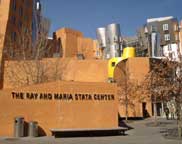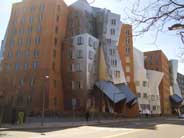The Stata CenterThe Stata Center is home to the Computer Science and Artificial Intelligence Laboratory (CSAIL), the Laboratory for Information and Decision Systems (LIDS), and the Department of Linguistics and Philosophy. In addition to these academic departments, the Stata Center has a fitness center, a childcare center, and a memorial to the former MIT building 20, which stood at this site for 55 years until it was demolished in 1998. The most famous product of Building 20 was radar; visitors can view one of its original radar dishes. Community SpaceEvent planners may want to know what space in the Stata Center is available for community use. The Teaching Center has a large lecture hall (auditorium), two tiered classrooms, and two flat classrooms. These five spaces are used primarily by the School of Engineering. The rooms offer substantial natural light (and blackout shades), advanced technology capabilities, and flexible seating and presentation configurations. To reserve a classroom, please call the Schedules Office, at 617-253-4788, or email schedule@mit.edu for more information. The 350-seat Dertouzos Amphitheater can host lectures, performances, and other special events outdoors. The TMSC Lobby is appropriate for small informational fairs or receptions. Please contact the Campus Activities Complex (3-3913) to reserve either of these spaces. About the BuildingAt its inception, the design of MIT'S interconnected buildings fostered collaboration, blurring lines among academic departments. Over time, however, the growth of the rectilinear campus and its increasing number of students, faculty, staff, and visitors traveling the Infinite Corridor made leaving one's door open to colleagues impossible. Architect Frank O. Gehry's challenge was to design a building that could house together the intelligence sciences and its researchers, who shared many of the same goals, within an open environment that encourages intellectual and social interaction. In the spirit of the early days of MIT, the Stata Center offers residents variations on a neighborhood scheme, facilitating cooperation and exchange of information among groups of researchers. Despite the building's complex exterior, the interior concept is simple: space for work that needs privacy or acoustic separation is set away from the common areas, while collaborative working spaces, lounges, and kitchens abut public areas. The Stata Center comprises two buildings: the William H. Gates and the Alexander Dreyfoos Buildings. These two towers form a C shape, each looking across an outdoor terrace to the other. Within the towers are two-story neighborhoods, where common lounges connect the levels with an open spiral stair. Within and connecting the towers is a two-level warehouse platform. The idea of the warehouse space came from the researchers, who wanted flexible, open labs with high ceilings: space that could be easily reconfigured and combined with adjoining labs for large-scale projects. Since one objective of the design program was to permit natural light to penetrate as much of the building as possible, offices, laboratories, and common spaces alternate their positions among the floors. The largest glass walls and roofs are located around the upper terrace, where they provide a visual connection among research neighborhoods and common spaces. Raised floors allowed for a modular electrical system, the phone and data networks, and a displaced air system. The flexibility of these systems will allow space changes without major renovations being necessary. Furthermore, the air system configuration allows individuals control of the temperatures in their spaces, but operable windows offer fresh air, as well. The Stata Center is built mostly of flat reinforced concrete slabs and columns, as concrete responds well to the type of shaping the architect proposed for the exterior of the building. Most of the columns are vertical, but some are sloped in some areas and in a few cases, the columns act in tension, supporting a slab from above. The enclosure of the exterior walls is of metal and brick, which is bridged with glass in many places. The entrances are articulated by ribbons of tinted titanium. The Stata Center is an environmentally friendly building, with a storm water management system as an example of progress in care for natural resources. A dry creek bed collects rainwater from adjoining roofs and surrounding plazas and retains it in a series of underground collection cells. This water is filtered through plantings and crushed stone, then it is sent either to a holding tank inside the building to be used for flushing toilets, or to the city's main drainage system. The pumps are powered by solar panels. Construction of the Stata Center is the second phase of a plan to enhance the accessibility and usefulness of the northeast quadrant of the MIT campus. The western end of the Center is connected on several floors to Building 36, home of the Electrical Engineering and Computer Science Department (EECS) and the Research Laboratory of Electronics (RLE). At the basement level, a tunnel connects to Building 26. The Center offers extensive outdoor space for its occupants and the community, with a series of interconnected plazas and gardens surrounding it and filling the roofs at various levels. MIT collaborated with the City of Cambridge to redesign Vassar Street, which now welcomes pedestrians and bikers with its extensive plantings, crosswalks, and bicycle lane. An underground service entrance to the Stata Center reduces traffic. Further development is planned for the Main, Vassar, and Binney street intersection, and the area will evolve into a definitive urban and civic space. For further information about the development of The Stata Center, view the facilities website here. |
 This is The Stata Center as seen from the campus and Dreyfoos tower side of the building. This is The Stata Center as seen from the campus and Dreyfoos tower side of the building.enlarge image |
